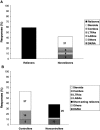Asthma control in Canada remains suboptimal: the Reality of Asthma Control (TRAC) study
- PMID: 16896426
- PMCID: PMC2683303
- DOI: 10.1155/2006/753083
Asthma control in Canada remains suboptimal: the Reality of Asthma Control (TRAC) study
Abstract
Background: Two Canadian studies showed that 55% of patients with asthma had daily symptoms (in 1996) and that 57% of patients suffered from poorly controlled asthma (in 1999).
Objectives: To assess the state of asthma control of adult Canadians, and asthma knowledge and practices of Canadian physicians actively involved in the care of patients with asthma.
Methods: Telephone interviews were conducted with adults 18 to 54 years of age who had been diagnosed with asthma at least six months before the survey, who did not have chronic obstructive pulmonary disease and who had a smoking history of fewer than 20 pack-years. Physicians were surveyed by telephone and mail. The surveys took place between April and August 2004.
Results: Almost all (97%) of the 893 patients believed that they had controlled asthma; however, only 47% had controlled disease according to symptom-based guideline criteria. Just 39% of 463 physicians based their treatment recommendations on the Canadian asthma guidelines most or all of the time, despite having a high awareness of them. Only 11% of patients had written action plans, and one-half of patients with action plans did not use them regularly. Almost three-quarters of patients expressed concerns about taking inhaled corticosteroids.
Conclusions: Since the last major national survey, guideline implementation has not resulted in significant changes in asthma-related morbidity. Effective means of knowledge transfer should be developed and implemented to improve the translation of guideline recommendations into care.
HISTORIQUE :: Deux études canadiennes ont révélé que 55 % des patients asthmatiques souffraient de symptômes quotidiens (en 1996) et que 57 % souffraient d’asthme mal contrôlé (en 1999).
OBJECTIFS :: Évaluer l’état du contrôle de l’asthme des adultes canadiens, ainsi que les connaissances sur l’asthme et les pratiques des médecins canadiens qui participent activement aux soins des patients asthmatiques.
MÉTHODOLOGIE :: Des entrevues téléphoniques ont été menées auprès d’adultes de 18 à 54 ans ayant reçu un diagnostic d’asthme au moins six mois avant l’enquête, ne souffrant pas d’une maladie pulmonaire obstructive chronique et fumant moins de 20 paquets-années. Les médecins ont été sondés par téléphone et par la poste. Les enquêtes ont eu lieu entre avril et août 2004.
RÉSULTATS :: Près de la totalité (97 %) des 893 patients pensaient que leur asthme était contrôlé, mais il l’était dans seulement 47 % des cas d’après les critères fondés sur les symptômes des principes directeurs. Seulement 39 % des 463 médecins fondaient presque toujours ou toujours leurs recommandations de traitement sur les principes directeurs du consensus canadien sur l’asthme, même s’ils connaissaient bien ces principes. Seulement 11 % des patients avaient des plans d’action écrits, et la moitié de ceux qui en avaient un ne l’utilisaient pas régulièrement. Près des trois quarts des patients s’inquiétaient de prendre une corticothérapie en aérosol.
CONCLUSIONS :: Depuis la dernière grande enquête nationale, l’implantation des principes directeurs n’a pas entraîné de changements significatifs de la morbidité reliée à l’asthme. Il faudrait élaborer et implanter des moyens efficaces de transmission du savoir pour améliorer le transfert des recommandations issues des principes directeurs en milieu clinique.
Figures






References
-
- Boulet L-P, Bai TR, Becker A, et al. What is new since the last (1999) Canadian Asthma Consensus Guidelines? Can Respir J. 2001;8(Suppl A):3A–27A. - PubMed
-
- Lemiere C, Bai T, Balter M, et al. Adult Asthma Consensus Guidelines Update 2003. Can Respir J. 2003;11(Suppl A):9A–18A. - PubMed
-
- Chapman KR, Ernst P, Grenville A, Dewland P, Zimmerman S. Control of asthma in Canada: Failure to achieve guideline targets. Can Respir J. 2001;8(Suppl A):35A–40A. - PubMed
-
- Juniper EF, Svensson K, Mork AC, Stahl E. Measuring health-related quality of life in adults during an acute asthma exacerbation. Chest. 2004;125:93–7. - PubMed
Publication types
MeSH terms
Substances
LinkOut - more resources
Full Text Sources
Other Literature Sources
Medical
Miscellaneous

